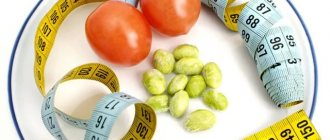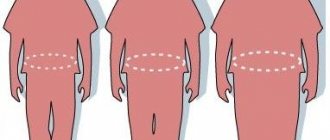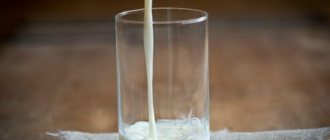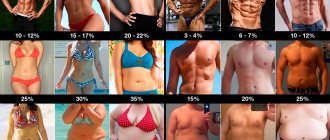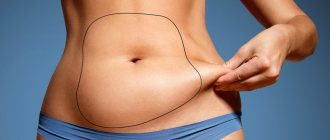Energy balance
The most common mistake is to consider the formula for energy balance in the body as a static “eat less and lose weight.” Anyone who has ever tried to lose weight has encountered the fact that after a certain point it stops losing weight, and additional cuts in calories do not lead to the desired result. One of the possible reasons is inflated expectations when a person strives for an unrealistic weight for his physique.
Our weight, like other vital functions, is controlled by the brain, which receives signals from the outside and from the inside (from the intestines, liver, fatty tissues and muscles). In this way, it regulates calorie expenditure, triggering various processes to optimize body functions. That is why the energy balance formula is very dynamic , and cutting back on your diet does not lead directly to weight loss.
| The less a person eats, the more the body tries to optimize processes and use incoming energy more efficiently. |
As a result of an artificially created lack of energy, many physiological mechanisms are activated, the purpose of which is to optimize the functions of the body in new conditions.
A 2021 study found that appetite and energy expenditure in the brain are regulated by a group of neurons. The processes of burning or saving calories “switch” depending on the current diet.
| The human body easily adapts to gain or lose weight in accordance with external factors and the body's needs. |
Where does he go?
As fat loss progresses, fat cells dramatically decrease in size, leading to visible changes in body composition.
Byproducts of Fat Loss
When fat deposits are broken down to produce energy through complex processes in your cells, two major byproducts are released: carbon dioxide and water.
Carbon dioxide is exhaled during breathing, and water is expelled through urine, sweat or exhaled air. The utilization of these byproducts increases significantly during exercise due to increased breathing and sweating.
Where do you lose fat first?
People usually want to lose weight in their stomach, thighs, thighs and buttocks.
Although losing weight in a specific area has not been proven to be effective, some people tend to lose weight from certain areas faster than others.
However, genetic factors and lifestyle play an important role in the distribution of fat in the body.
Additionally, if you have a history of weight loss and weight regain, body fat may be distributed differently due to changes in fat cells over time.
Why is it so difficult to lose weight?
When you eat more than your body can burn, fat cells increase in both size and number.
When you lose fat, these same cells may shrink in size, although their number remains about the same. Thus, the main reason for changes in body shape is a decrease in the size, not the number of fat cells.
This also means that when you lose weight, fat cells remain and if no effort is made to maintain the weight loss, they can easily grow back in size. Some research suggests that this may be one of the reasons why maintaining weight loss is so difficult for many people.
Summary: During weight loss, fat cells decrease in size as their contents are used for energy, although their number remains the same. Byproducts of fat loss include carbon dioxide and water, which are removed through breathing, urination and sweating.
Why does weight loss happen?
Essentially, the weight loss process begins with a negative energy balance . This means that during this period the number of calories consumed is less than needed for the daily functions of the body.
The body perceives such a balance as a signal that “hard times” have come, and starts a mode for optimizing energy consumption .
When a person limits the amount of incoming energy in the hope of losing weight, the body does not know that there is, in fact, incredible abundance around and this limited access to food is artificially created - it is programmed to survive.
| Our body knows how to incredibly efficiently distribute available resources to save energy, and when they are abundant, put aside reserves for a “rainy day.” |
Weight Loss Phases
Weight loss involves the loss of fat and lean mass, which is the sum of protein (muscle tissue), glycogen, water, minerals and electrolytes.
Typically, the first phase of weight loss is characterized by relatively large protein losses. First of all, the body consumes proteins contained in the gastrointestinal tract and liver, then in skeletal muscles and, to a lesser extent, in internal organs.
An initially thin person who loses 10 kg of fat risks losing about 15 kg of muscle tissue. With significant obesity, the amount of muscle mass lost decreases. It is important to understand that intense loss of fat-free mass occurs only in the first 4 weeks, that is, in the first phase of weight loss. Once the body reduces the basal metabolic rate to a minimum and enters the second phase of weight loss , fat becomes the main source of energy.
| Basically, the composition of lost body weight is determined by two factors - the initial constitution of a person and the severity of the diet. |
The most common goal when working on the body is the desire to reduce the percentage of fat and maintain or increase muscle mass. To do this, you need to figure out which parameters will help achieve the desired result.
With weight loss and a negative energy balance, the rate of reduction in fat mass will depend on the balance of diet and physical activity.
| An excessively low-calorie diet suppresses the metabolic rate and promotes greater breakdown of protein tissue than a balanced diet and gradual weight loss. |
The process of losing weight is more complicated than “Eat less calories than you burn”!
How fat loss works
Excess energy consumed—usually calories from fat or carbohydrates—is stored in fat cells in the form of triglycerides. This is how your body conserves energy for future needs. Over time, this excess energy leads to excess fat, which can affect your figure and health.
To promote weight loss, you need to consume fewer calories than you burn. This is called a calorie deficit.
Although it varies from person to person, a daily 500 calorie deficit is a good start to start noticing fat loss.
By maintaining a constant calorie deficit, fats are released from fat cells and transported into the energy machinery of your body's cells called mitochondria. Here fat is broken down through a series of processes to produce energy.
If the calorie deficit continues, body fat stores will continue to be used as energy, resulting in decreased body fat.
Summary: Over time, a consistent calorie deficit releases fat from fat cells, which is then converted into energy to fuel your body. As this process continues, the body's fat stores decrease, leading to changes in body composition.
Diet composition and weight loss
The composition of the diet plays an important role in the process of losing weight. In addition to the total amount of energy consumed, the physiology of weight loss is influenced by macronutrients, various microelements, and electrolytes.
For example, weight loss on a high-protein diet may be much greater than on a low-calorie, nutrient-balanced diet. However, this difference will be due primarily to differences in water balance, and fat and protein losses will be approximately equal.
Scientists have found that there is an approximate lower limit of calorie intake - 1200 kcal/day . If caloric intake falls below this level, the body can activate physiological defenses against weight loss.
Additionally, fasting as a weight loss technique results in highly disproportionate protein loss. The rate of weight loss during a low-calorie diet and during fasting is almost identical, but the intensity of muscle loss during a low-calorie diet is much lower than during fasting.
| The rate of fat burning with a balanced diet is much greater than with fasting or an extremely low-calorie diet. |
With a low-calorie diet, metabolism quickly adapts - it slows down, which makes such diets not only dangerous, but also ineffective for losing weight. At some point, weight loss decreases, and the body begins to compensate for the lack of energy in other ways.
Weight loss and sports
| Physical exercise is the most studied means of preventing metabolic slowdown and loss of muscle mass. |
Exercising increases your energy intake during and after exercise and encourages you to burn fat instead of carbohydrates. In addition, physical activity prevents muscle loss and stimulates its gain. Growing muscle tissue requires more energy, which prevents a decrease in metabolic rate.
Diet and exercise are the key to success
The two main factors for fat loss are diet and exercise.
When there is a sufficient caloric deficit, fats are released from fat cells and used as energy.
Exercise enhances this process by increasing blood flow to muscles and fat cells, releasing fats that will be used to produce energy in muscle cells at a faster rate and increasing energy expenditure.
To promote weight loss, the American College of Sports Medicine recommends at least 150 to 250 minutes of moderate-intensity exercise per week, which equates to about 30 to 50 minutes of exercise 5 days a week.
For maximum benefit, these exercises should be a combination of strength training to maintain or increase muscle mass and aerobic exercise to increase calorie burning.
Common resistance exercises include lifting weights, while examples of aerobic exercise include running, cycling, or using an elliptical machine.
When calorie restriction and a nutritious diet are combined with the right exercise regimen, fat loss is greater than using diet or exercise alone.
For best results, consider seeking help from a registered dietitian for dietary guidance and a certified personal trainer for exercise programming.
Summary: Diet and exercise are the main causes of fat loss. A nutritious diet that maintains an appropriate calorie deficit combined with adequate exercise is the recipe for sustainable fat loss.
FAQ
| Do we speed up our metabolism when we eat small, frequent meals? |
When we eat frequently, we do NOT speed up our metabolism. The scientific literature on this topic indicates that if one person eats X amount of calories in one meal and another eats the same amount in 3 or even 6 meals a day, there will be no difference in weight loss. It follows that more frequent meals do not contribute to more effective weight loss.
Should you eat often or rarely? There is no clear answer.
On the one hand, frequent small meals help many people control the feeling of hunger, and as a result, a person does not overeat.
Research shows that a person who eats their daily calorie intake in one sitting will be more likely to overeat later on because it's hard to maintain moderation if you haven't eaten all day.
| Severe hunger pushes you to overeat. |
People who skip meals signal to the body that resources are limited, activating all the ancient survival mechanisms. The body will demand food, and when it receives it, it will stock up for future use, because it has no idea when the next meal will be.
| By eating in moderate portions and when you feel hungry, you let your body know that there will ALWAYS be enough food! |
One study of the nutrition of athletes showed that if they eat small portions and often, then the percentage of fat relative to muscle mass is lower compared to athletes who eat once or twice a day, but in huge portions.
The researchers concluded that this is related to how many hours a day a person is in negative energy balance. Having eaten once, the body goes into a huge positive state, but then spends most of the day in an energy deficit, recovering only in the evening with the last large meal.
However, there are some people who are better off eating infrequently - some research suggests that eating 2 or 3 meals a day can help improve carbohydrate metabolism in people with endocrine disorders. For some, it is simply the most convenient option due to work circumstances or personal preference.
To find your own option, try different approaches - your personal comfort and body reaction will tell you what works best.
Authors: Elena Degtyar, PhD Elena Dedyaeva, MSc
Literature:
- Prentice AM. (1991) Physiological responses to slimming. Proceedings of the Nutrition Society 50, p. 441-458
- Heymsfield SB. (2011) Voluntary weight loss: systematic review of early phase body composition changes. Obesity reviews 12, p. 348-361
- Heilbronn LK (2006) Effect of 6-month calorie restriction on biomarkers of longevity, metabolic adaptation, and oxidative stress in overweight Individuals. A randomized controlled trial. JAMA, 295, no. 13
- Schwartz A. (2010) Relative changes in resting energy expenditure during weight loss: a systematic review. Obesity reviews 11, p. 531-547
- Keim NL. (1990) Energy expenditure and physical performance in overweight women: response to training with and without caloric restriction. Metabohsm, 136 (6), p. 651-658.
- 6. Major (2007) Clinical significance of adaptive thermogenesis. International journal of obesity 313, pp. 204-212.
- Dokken (2007) The physiology of body weight regulation: Are we too efficient for our own good? Diabetes spectrum 20 (3): 166-70.
- Levine JA (2006) Non-exercise thermogenesis. The crouching tiger hidden dragon of societal weight gain. Arterioscler Thromb Vasc Biol. 26 (4): 729-36.
- Galgani J (2008) Energy, metabolism, fuel selection and body weight regulation. International journal of obesity 32: S109–S119.

